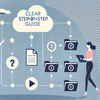
The selling process is often regarded as art, as sales depend greatly on the talent some salespeople have (and some don’t). You may call it charisma, charm, magnetism, or personal attractiveness. Whatever it is, there is something irrational in the sales process that cannot be explained.
This is partly because selling is primarily based on non-verbal communication – the chemistry that happens when some people start talking to you. They say these skills can be mastered, and you can even attend some courses where they will teach you to breathe exactly like the people you are talking to and synchronize your movements with theirs. This might help. But will it really? You can learn some tricks, but you can hardly learn the art.
If you are not a sales guru with irresistible non-verbal communication skills, you’d better think of the verbal part of the sales process, which you can enhance by creating and improving your sales documentation.
This blog will explain what sales documentation is, why it is important, and how help authoring tools can be helpful at different stages of the sales process.
What Is Sales Documentation?
Sales documentation is an essential step for making your business process efficient. It is a way to attract leads to boost the company’s revenues.
Sales activities are often spontaneous. They need to be manageable, streamlined, and controllable. This can hardly be achieved without sales documents, such as:
- sales process playbooks,
- pricing documents,
- case studies,
- scripts,
- etc.
All these can help your sales representatives (sales reps) get a clearer vision of what their daily routine should look like, what their sales roles are, what strategies and techniques they should use, and what results they should achieve.
This will prevent your sales team from using different tactics in dealing with leads. The activities of your employees will become more uniform and, actually, ‘team-like.’
Consistency is a part of brand recognition.
Customers won’t associate your sales reps with your product or company without it.
Sales documentation will make the work of your personnel transparent and, therefore, controllable. You will be able to assess how the sales reps follow the scripts developed in the company (these are standard dialogues that have proved to be most effective when contacting prospective customers). You will be able to introduce other sales training documents that will facilitate the onboarding new hires in your sales team.
Summing up, sales documentation is a step-by-step instruction concerning what your sales reps must do to close deals. It can be presented as a list of actions/stages, a diagram, a flow chart, or all these combined). The documentation should describe the sales process in all details, from introduction to dealing with the possible objections of potential customers.
A step-by-step approach will be useful both for experienced specialists and new hires who are in the process of onboarding. A detailed sales document will outline the structure of communication with the customer, help everyone visualize the sales pitch process, and align all the ways and methods used in the company.
The Advantages of Sales Documentation
The benefits of sales documentation can be summarized in the short list below:
- automation,
- standardizing,
- recognition,
- transparency,
- control.
Now, let’s have a closer look at these advantages.
Automation. As your business grows, your sales activities expand as well. To avoid the risk of losing control over the numerous interactions with customers, you should ‘automate’ the sales process. The term ‘automation’ is traditionally associated with the production process. However, it can be applied to non-production areas. In fact, it applies to any field where the process can be repeated many times.
In sales, it means that scripts and pitches (often repeated dialogues with customers) are recorded to find the optimal variant and disseminate it in the company. With the help of sales documentation, the process of communication is automated. Sales reps no longer work ‘on their own’ trying to reinvent the wheel each time they have to talk to a new customer. They start working as a tight-knit team of professionals using the standard of sales communication elaborated in the company.
Standardizing. This is the direct result of automation. Standard is convenient for disseminating information about your product. With minor adjustments, standardized content can be applied to any target audience.
Creating standard pitches and scripts can be done through the joint efforts of the sales team. Corporate training sessions are a great forum for sharing ideas. Usually, this is how sales documentation accumulates the experience of sales communication and standardizes it for further use.
Some may say that a company standard makes all salespeople sound like robots. This annoys customers and makes them stop listening after a few first lines.
Unfortunately, this may be the case when an inexperienced salesperson tries to learn the script ‘by heart’ and reproduce it without a single deviation. The speech will hardly inspire a potential customer. This often happens when the salesperson is not motivated to sell the product. If your company has such a problem, you must consider how to solve it.
Recognition. This is another advantage that sales documentation will ensure, and it is closely related to the ones listed above. Standard means uniformity and consistency – the two factors of brand recognition. A standard description of a product acts like a verbal label. For customers, it pins the product on the map.
Without consistency, your product won’t be positioned on the market. Customers won’t be able to single it out from a dozen of competing products.
To make your brand (product, company) recognizable, you have to offer the target audience a ready-made description of the product and its advantages. Don’t wait for your customers to do market research, compare and analyze different products, and opt for yours. This will never happen. People are too lazy to do all the thinking. It is you who should tell customers how your product will solve their problems.
Transparency. Proper sales documentation will make the workflow more transparent for managers and employees. Sales reps will have access to all the information they need to communicate with customers (sales pitches, scripts). Managers will be able to introduce new collateral in the sales process and control customer communication by setting and adjusting sales documentation.
Control. Transparency makes control convenient and effective. The skills of sales professionals and the way they follow the instructions outlined in sales documentation can be assessed at training sessions or during live communication under the supervision of a manager. This will give you input on the workflow and the way it can be corrected.
Now, considering all of the above, we can say that writing sales documentation will transform sales from chaotic and disorganized speeches to streamlined, transparent, and controllable communication. As a result, sales will become an easy-to-follow process for your team.

Steps to Write Sales Documentation
The selling process starts much earlier than we used to think. It cannot be reduced to communication with customers and closing deals. Actually, the selling process starts with creating sales documentation, though, in practice, writing supporting documentation often starts only when problems occur (such as claims from customers and sales drops).
Best practices show that writing a sales document should take place prior to starting the selling process. Sales content writing can be split into several steps or stages:
- Outlining the purpose of the document. The purpose can be different depending on the nature of the document: to provide the sales team with the necessary information or with collateral for communication with customers. In any case, formulating the purpose is important. Otherwise, the document will just end up in one of the company’s information silos, among other unwanted and unused docs.
- Preparing templates. These are part of the standardizing advantage described above. The more standard forms and docs the employees have, the faster they work. If templates are available, your specialists won’t have to write things from scratch each time they interact with the target audience. Good examples are email templates and sales scripts. These can be very helpful in the daily routine of a sales rep.
- Preparing a package of documents needed for a sales pitch. This means tailoring sales documentation for a specific customer. The documents for each specific sales pitch should be based on the customers’ unique situations.
- Handling complaints. Your documentation should describe how to handle the possible objections of potential customers. Provide your sales reps with a list of compelling reasons that will refute the complaints and push the customers down the sale funnel.
The list above is not limited to just four points. You can make it more detailed to give your employees a better vision of the sales process.
ClickHelp Is the Best Tool to Create Sales Documentation
ClickHelp is a help authoring online platform that can facilitate your sales content creation. With ClickHelp, it will be enough to create one generic document for each communication type (sales pitch, cold sales script, sales email, etc.). The generic document will be reused for creating other versions adapted for specific sales conditions considering a product, its parameters, pricing, customer needs, etc.
This is possible due to ClickHelp features such as content reuse and single sourcing. The system regards all the content created or imported into it as separate text fragments that can further be used for creating new content.
This is especially convenient for the sales process, where content tends to be duplicated and re-duplicated. This is because scripts for different products have similar content, as human communication (dialogues between sales reps and prospects) generally follows one psychological pattern, including such stages as denial, bargaining, and acceptance. The wording may be slightly different, but the general pattern is the same.
An obvious advantage of ClickHelp is that the system is easy to use. It is import-friendly, and you can easily migrate your content from other systems. It requires practically no training. Questions can easily be solved with context help or by directly addressing the support team. On the whole, the UI is intuitive, and users can start working right away with creating, publishing, and even translating content.
Another very useful feature offered by ClickHelp is full-text search. It will enable your salespeople to search not only in the text of an article but throughout the entire portal. All the collateral will be right at hand, and speeding up further sales content creation.
Full-text search is available on the ClickHelp website. You will get the result by submitting the search term in the search bar. The fuzzy search feature will find partial matches even if you don’t type the exact term or phrase.
Another advantage is predictive search. It allows the user to only start typing and then select the search formulation from the system suggestions shown in the dropdown.
An automatic error correction makes search possible even in case you make mistakes and misprints while typing.
All this (and much more) makes ClickHelp the best choice for your sales team.

Conclusion
Creative people may have a negative attitude towards standards. Still, companies where sales teams use supporting sales documentation have proved more efficient in revenue than teams with no standardized documentation.
Documentation increases customer loyalty, giving prospects a better experience during communication with sales reps. On the other hand, it saves reps a lot of time as they don’t have to write sales pitches from scratch each time they interact with a new customer.
Sales documentation also facilitates the onboarding of new hires. Your new reps will get experienced much faster and will sell more in a shorter amount of time. As a result, your company will grow faster and work more efficiently than its competitors.
Good luck with your technical writing!
ClickHelp Team
Author, host and deliver documentation across platforms and devices



